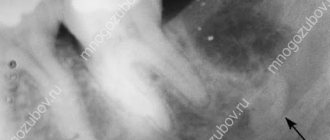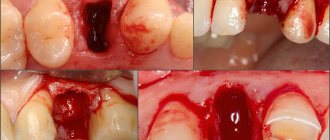A simple gingival incision is often confused with a resection. The latter is not just an incision, but an excision of the gum, removing part of it.
Dissection of the gum consists of opening it with a sharp instrument in the following conditions:
- purulent lesions - gumboil, periodontitis, abscess, phlegmon;
- infections at the root of the tooth – periostitis, periodontitis;
- implantation of a denture;
- a gingival hood over a wisdom tooth due to its slow eruption and abnormal growth.
In all these cases, gum resection may be required if the surgeon discovers excess tissue or determines that it is impossible to restore it conservatively.
Gum excision
Excess gum tissue or tissue that cannot be restored is cut off:
- In case of violation of the eruption of molars - their retention, pericoronitis.
- If there are pathological formations at the root apex - cysts or granulomas.
- If an abnormality in root development is detected during tooth extraction.
- If the crown is destroyed - to ensure the removal of all fragments.
- For inflammation leading to non-viability of the gums - periodontal disease, gingivitis, periodontitis.
Removing tissue promotes better gum restoration.
Indications and contraindications
Most often, the indication for an incision is the need to ensure the drainage of pus from the area of inflammation.
The gum is incised to remove a tumor, cyst, or foreign body, such as a stuck bone.
To install fasteners during dental implantation, with impacted teeth, when braces do not help, the gums are also sometimes cut.
When using veneers, the gum sometimes moves away from the tooth. Then gum plastic surgery is indicated, which is performed with an incision.
Relative contraindications for incision are:
- Allergy to local anesthetics. If an incision is unavoidable, the surgeon selects the anesthetic to which the patient does not have an allergic reaction.
- Unsanitized oral cavity. Before the incision, it is sanitized.
- Acute infections are a contraindication only for elective gum surgery. For purulent inflammations, when urgent intervention is needed, it is done under the guise of antibiotics.
- HIV infection. The operation is performed against the background of immunomodulators.
- Oncology. The intervention is carried out after antitumor treatment.
- Diabetes. Before and after the gum incision, it is necessary to treat the wound with drugs that promote tissue healing, for example, Solcoseryl.
- Mental disorders of the patient that prevent adequate communication. Then anesthesia is used during the intervention.
- Blood clotting diseases. The incision is made against the background of anti-clotting agents.
Stages of the operation. How to cut gums in dentistry
No matter how the gum is cut, the procedure is the same:
- Examination and antiseptic treatment of the oral cavity, professional cleaning, and, if necessary, radiography.
- Anesthesia - local or anesthesia.
- Selecting the type of cut and the cut itself.
- Basic treatment methods: installation of a drainage system in the wound to release purulent exudate for up to 3 days, removal of a tumor, cyst, installation of prosthetic elements.
- Stitches are applied and removed within 5–7 days.
Before surgery, preparation is often carried out with immunomodulators, restoratives, anti-inflammatory, and antiallergic drugs. After surgery, antibiotics may be prescribed for 3–5 days due to the risk of purulent inflammation.
There are a number of methods for cutting gums.
A vertical incision from the edge of the gum (gingivotomy) is usually performed for periodontitis.
In flap dissection, a series of horizontal and vertical incisions are made. This type is divided into the following stages:
- coronal displacement with detachment of a tissue flap and covering of the exposed dental root system with it;
- formation of a lateral flap to cover isolated small areas of exposed roots, for example, with periodontal disease;
- the most traumatic V-shaped incision with the addition of donor gum tissue to the resulting flap to cover not only a small, but also a larger area of the exposed root;
- the Ramfjord method for accessing the diseased root - the gum is dissected at the periodontal pocket, the edges of the flap are moved apart and returned to their place after removing the affected tissue;
- cross-shaped incision for flux.
The surgeon chooses the type of incision that is justified in a specific clinical situation.
Gingivectomy - what is it?
With advanced periodontal disease, pockets form into which food debris gets trapped.
Over time, they become the cause of infection. If treatment is not started in a timely manner, serious negative consequences are possible, including removal of infected bone tissue and teeth. Gingivectomy can prevent this. The operation can be carried out either locally, when one tooth is affected, or on a large scale - if necessary, treat several units at once. Initially, dentists try to cure periodontal pockets using therapeutic methods. However, this often does not give the desired result, especially if the depth of the pockets reaches 2 mm or more. As a result, there is a need for an operation to excise the gingival margins.
The dentist first measures the depth of the pocket. Based on these and other data, a decision is made on further treatment tactics. The sooner the patient turns to a specialist, the higher the likelihood of solving the problem through simple therapeutic means. If there is no chance of successful treatment with this method, surgery is prescribed.
Advantages
- Getting rid of the source of infection.
- Restoring the aesthetics of the oral cavity.
- Improved overall well-being.
Flaws
- Long recovery time.
- The need to strictly follow the dentist's recommendations.
- Obligatory observation by a specialist over the next two weeks.
- Restrictions on food and lifestyle during the rehabilitation period.
Contraindications
- Low level of immune defense
- Bacterial endocardid
- Congenital heart disease and other cardiovascular diseases
- Cirrhosis of the liver
- Bridle or cords in the area of the operation
- Blood diseases
- Inflammation of bone tissue
Indications
- Periodontitis, gingivitis
- Deep pockets between tooth and gum
- “Gummy smile” - achieving an aesthetically pleasing oral cavity
- Epulis
- Large size of interdental papillae, gum grows onto the crown
- Subgingival location of the filling
- The need for root polishing
How long does it take for gums to heal after an incision? How long does it take for the swelling to go down?
In order for the gums to heal, after surgery a blood clot must form in the wound within 10–12 minutes. It prevents pathogenic bacteria from entering the incision site and after 3-4 hours it is converted into granulation - young gum tissue. Epithelial coverage occurs by 10 days, and healing of the wound occurs within 2–3 weeks. It will heal completely in two months.
Healing times are determined by a number of factors and increase:
- proportional to the volume of surgical trauma;
- with age;
- with low immunity;
- for underlying diseases (diabetes, inflammation, HIV, oncology).
Applying sutures speeds up the healing of the wound edges brought together by the sutures.
How many days the swelling will go down depends on the extent of the operation:
- in case of injury to a large area, the swelling does not subside for several days;
- the presence of purulent inflammation before surgery prolongs the period of tissue swelling until all the pus comes out, so drainage is left in the wound for several days;
- when installing implants or prosthetics, cheek swelling can last up to 1 week, but if it grows or increases pain, you need to consult a dentist - perhaps the installation was incorrect;
- If there are complications, the swelling will not subside and will increase - this is a signal for an urgent visit to the dentist.
A condition where the cheek is swollen after surgery is considered normal if the bump lasts no more than 3-5 days. Otherwise, you need to consult a surgeon.
Tissue augmentation – during recession and implantation
Gum grafting with root exposure (recession)
solves not only aesthetic, but also medical issues, protecting this part of the tooth from increased sensitivity, caries formation and other problems. One of the common causes of recession is periodontitis and gingivitis. A similar disorder also occurs with periodontal disease; if the gum tissue is too thin; due to improper oral hygiene and a number of other reasons.
Build-up may also be required when installing an implant - when a tooth is removed, the volume of bone and gum tissue decreases over time. Accordingly, if it becomes insufficient for implantation, the tissue is built up. Sometimes it is necessary to work only on the gingival contour - so that the implant looks as aesthetically pleasing and natural as possible.
To cover exposed areas, so-called patchwork plastic surgery is often used. The doctor cuts the tissue in the treated area and replaces/extends the resulting flaps using flaps taken from the palate, cheek, and other areas of the periodontium. Then stitches are applied.
How to rinse your mouth after a gum incision
Rinsing the mouth after surgery is not done immediately, so as not to wash out the blood clot from the wound.
They use pharmaceutical products: chemical and herbal, as well as those prepared at home.
| Ready-made products | Home Remedies | |
| Chemical | On herbs | |
| Chlorhexidine | Stomatophyte | Infusions: · sage; · chamomile; · oak bark; · calendula; take 1 tbsp. for 1 tbsp. boiling water, leave for 15–30 minutes, strain, cool, add to a volume of 200 ml |
| Miramistin | Maraslavin | Saline or soda-salt solution (1 teaspoon each of soda and salt, preferably sea salt, per 1 cup of water) |
| Furacillin | Rotokan | Light pink solution of potassium permanganate |
In addition to general recommendations, the doctor will advise what to rinse the mouth of a particular patient.
You need to rinse after each meal until swelling and pain disappear. Sometimes the same products are used for applications and lotions on the incision area.
Hood over figure eight
Between the wisdom tooth and gum there is a space called the hood. As a rule, the hood has a scarlet or slightly bluish color and a rounded shape. Food particles and dead epithelium often penetrate into the periodontal space, thereby provoking the active proliferation of bacteria, leading to the development of inflammation. In such a situation, the hood, in which microorganisms have accumulated and multiplied, is excised.
The process of wisdom teeth erupting may be accompanied by swelling, pain and difficulty opening the mouth. If you add to the process an infection inside the hood, which can also spread to neighboring teeth, there is a danger of complications developing. Therefore, to prevent the development of negative consequences, the hood of the eighth tooth is excised.
Complications after surgery
Complications of gum incisions include:
- fever, indicating current inflammation;
- swelling of the gums;
- boring, burning pain radiating to the jaw bone, ear;
- bleeding 1–2 hours after surgery;
- flux.
Self-medication here is dangerous, since any of the complications may require repeated incision of the gums.
Edema and swelling
Swelling at the wound site for 2–3 days is acceptable. If it spreads to the cheek, this may be a sign of alveolitis - inflammation of the socket, requiring repeated intervention.
Heat
With normal healing, the temperature gradually drops by day 4–5. If it lasts longer and becomes higher, the wound has become infected and a new operation is needed.
Pain
The pain gradually subsides. When it increases, the appearance of a new character, severity, coupled with swelling and high temperature, surgical treatment of a purulent infection is required.
Bleeding
When the gums are cut, bleeding occurs after 1–2 hours. Homemade hemostatic agents are used: hydrogen peroxide, applying a tampon to the wound. If the patient sees that the bleeding does not stop, urgent assistance from a dentist is needed.
Flux
With increased pain and swelling, inflammation can spread to the periosteum of the jaw, and gumboil occurs. Surgical treatment is needed.
Alternative options
- Cleaning teeth using ultrasound . Tartar is destroyed, the integrity of the unit is preserved.
- Drug treatment using antiseptics. The best option is Chlorhexidine in the form of rinses or compresses.
- A course of antibiotics . Allows you to quickly relieve the inflammatory process and alleviate the human condition.
Conservative treatment is not always effective. If characteristic symptoms reappear or the situation worsens, gingivectomy becomes mandatory.
Recommendations after gum incision
After the operation, the dentist will tell you what can and should be done, and what it is better to refrain from.
- Do not eat or drink for 3–4 hours, do not touch the wound with your tongue, and do not rinse your mouth on days 1–3. Baths with antiseptics and application of gel are possible - Solcoseryl, Cholisal, Kamistad, from the 3rd day - rinsing.
- During the week, use gentle, soft food.
- Eliminate physical activity on the 1st day, alcohol and smoking for a week.
- Any warming (bath, sauna, swimming pool, compresses) and cauterizing procedures (alcohol, iodine, brilliant green) are prohibited for a week.
- If you have sutures, you should not open your mouth too much when eating or talking.
- For pain, take a painkiller (Analgin, Ibuprofen, Ketanov), apply cold.
- After a week, as prescribed by the doctor, physical therapy (electrophoresis, UHF, magnetic laser, paraffin applications) is possible, which improves regeneration.
Following the doctor’s recommendations will help avoid complications and ensure rapid healing of the incision on the gum.
Indications
The operation may be prescribed in the following cases:
- “Short teeth” due to too wide a band of gum tissue.
- An uneven edge that looks unsightly.
- The gap between the gum and tooth (pocket) is too large.
- Inflammatory processes (periodontitis, gingivitis), which serve as an obstacle to fixation of the crown.
- Damage to gum tissue with the risk of spreading to neighboring areas.
There are a number of indications for the operation.
In these cases, tissue must be removed not only for aesthetic reasons, but also due to the fact that the gap between the teeth and gums is a place where bacteria accumulate, which can lead to the development of inflammatory processes.
The operation is not performed if there are contraindications , which include:
- decompensated diabetes mellitus;
- blood diseases;
- cardiovascular diseases in the stage of decompensation;
- infectious diseases in the acute stage;
- immune pathologies.
In addition, surgery is not indicated if the inflammation has already affected the bone tissue.
Gum extension techniques
There are two main methods of gingivoplasty:
- flap plastic surgery – tissue from the patient’s oral cavity is used. The doctor incises a section of the gum and, using a tissue flap from other areas of the mucous membrane (adjacent gum, palate, inner part of the cheek), forms a contour,
- extension with collagen matrices or barrier membranes - the material is tightly sewn to the area of the gum that needs to be restored, and then the body forms its own tissues based on the material.
Excision of wisdom tooth gums - prices
Treatment of pericoronitis;
excision of mucous membrane, retention cyst 1500 rub.
Anesthesia - 1 carpule
550 rub.
Wisdom teeth bring trouble to many patients - they rarely erupt and grow without any problems. Eights develop in adulthood, when the molars have long been formed, and sometimes there is no room left for them - accordingly, the process of the appearance of wisdom teeth can bring a lot of discomfort. They are located in the gums somewhat deeper than other crowns - because of this, eruption can be hampered by a layer of mucous membrane. Such a peculiar hood can significantly complicate the process of the appearance of eights.
Family Discount Dentistry offers a wide range of dental surgery services, including excision of the hood over the wisdom tooth. This procedure avoids further complications and also facilitates the eruption of figure eights. Often the gums above the wisdom tooth become inflamed - this is almost always accompanied by the same symptoms.
Types of gum plastic surgery
- gingivoplasty - restoration of gum volume during its atrophy, that is, recession, or implantation;
- gingivotomy - dissection of the wall of the periodontal pocket to perform open curettage;
- gingivectomy - cutting off part of the overgrown gum in the presence of large gum pockets.
Content:
- Why does a wound take a long time to heal after tooth extraction?
- How gums heal normally
- Gum healing time
- How to speed up gum healing after tooth extraction
- What complications can tooth extraction cause?
Healing after tooth extraction can proceed quickly or take a long time. The second option is extremely undesirable and dangerous to the patient’s health. Therefore, it is important for the patient to know how long the regeneration process takes, what symptoms indicate a secondary infection, and how recovery can be accelerated.
What complications can tooth extraction lead to?
Normally, restoration of injured tissue occurs within three weeks. The red, inflamed gum gradually acquires a pale pink color and ceases to be painful on palpation. But if a person has diseases that prevent rapid recovery, or he does not comply with doctor’s orders, then the rehabilitation process can be difficult. Then the patient will face complications, including:
- hematoma;
- severe swelling of the soft tissues of the cheek;
- frequent bleeding from the wound;
- numbness of the tongue, cheeks, lips;
- pain while eating.
If the healing of the hole is in doubt - a person thinks that something is going wrong - he should immediately consult a doctor. The doctor will conduct an examination and tell you whether you need to use any drugs to speed up regeneration.










